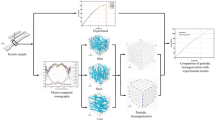Abstract
Both elastic modulus and strength of injection molded carbon fiber filled poly-ether-ether-ketone (PEEK) composite are studied under tension. The measured moduli and ultimate strengths of injection molded carbon fiber reinforced PEEK have been compared with the model predicted values. For injection molded PEEK composite, the experimentally obtained values of tensile modulus show a fair agreement but those of the tensile strength show a poor agreement with the theoretically predicted values. Many processing factors seem to be more critical issue for the strength than the stiffness of short-fiber reinforced composites. Considering the service performance of composites depends on three interactions — material, design and processing, monitoring the processing can be critical to have a best performance of composite. Processing factors have been discussed in cases of short carbon fiber reinforced PEEK composite based on the comparision between experimental and theoretically predicted data to obtain the best composite material.
Similar content being viewed by others
References
Chen, P. E., 1971, “Strength Properties of Discontinuous Fiber Compositer”,Polym. Eng. Sci., 11, No. 1, p. 51–66.
Chung, S. T. and Kwon, T.H., 1995, “Numerical simulation of Fiber Orientation in Injection Molding of Short-Fiber-Reinforced Thermoplastics”,Polm. Eng. and Sci., Vol. 35, No. 7, p. 604–618.
Cogswell, F. N., 1992,Thermoplastic Aromatic Polymer Composites, Butterworth and Heineman.
Christensen, R. M. 1979.Mechanics of Composites Materials, John Wiley & Son.
Christensen, R. M. and Waals, F. M., 1972, “Effective Stiffness of Randomly Oriented Fiber Composites”,J. Comp. Mater., 6, pp. 518–532.
Cox, H. L., 1952, “The Elasticity and Strength of Paper and Other Fibrous Materials”,British J. Appl. Phys., Vol. 3, pp. 72–79.
Curtis, P. T., Bader, M. G. and Bailey, J. E., 1978, “The Stiffness and strength of polyamide Thermoplastic Reinforced with Glass and Carbon Fibers”,J. of Mat. Sci., 13, pp. 377–390.
Fukuda, H. and Chou, T. W., 1981, “A Probabilistic Theory for the Strength of Short Fiber Composites”,J. Mater Sci., 16, p. 1088–1096.
Gibson, R. F., 1994,Principles of Composite Material Mechnics, McGraw-Hill Inc.
Halpin, J. C. and Kardos, J., 1978, “Strength of Discontinuous Reinforced Composites: I. Fiber Reinforced Composites”,Polym. Eng. Sci., 18, No. 6, p. 496–504.
Hahn, H. T., 1975, “On Approximations for Strength of Random Fiber Composites”,J. Comp. Mater., 9, p. 316–326.
Hashin, Z., 1962, “The Ealastic Moduli of Heterogeneous Materials”,J. Appl. Mech., Vol. 29, pp. 143–157.
Hill, R., 1964, “Theory of Mechanical Properties of Fiber-strengthed Materials: I. Elastic Behavior”.J. Mech. Phys. Solids, Vol. 13, p. 199.
Horio, M. and Onogi, S., 1951, “Dynamic Measurements of Physial Properties of Pulp and Paper by Audiofrequency Sound”,J. Appl. Phys. 22, No. 7, pp. 971–977.
Kelly, A., 1973,Strong Solids, 2nd ed., Clarendon Press, Oxford, England.
Kelly, A. and Tyson, W. R., 1965, “High Strength Materials”, Edit. by V.F. Zackay, Chapt. 13, John Wiley, N. Y.
Lavengood, R. F. and Goettler, L. A., 1987, Contract Report,ONR/ARPA, Contract No. NOOO14-67-C-0218.
Lee, D, J. and Chin, H. B., 1990,Research Memorandum, Allied-Signal Inc.
Lee, D. J., Jeong, T. H. and Kim, H. G., 1995, “Effective Longitudinal Shear Modulus of Unidirectional Composites”,Proc. in 10th Int. on Compos. Mat., Vol. 4, Whistler, Canada, pp. 171–179.
Lee, J. K. 1968. “A Study of the Tensile Strength of Short Fiber Reinforced Plastics”,Polym. Eng. Sci, 8, No. 3, p. 195–202.
Piggott, M. R., 1980,Load Bearing Fiber Composites, Pergamon Press.
Riley, V. R., 1968, “Fiber/Fiber Interaction”,J. Compo. Mater., 2, p. 436–446.
Robinson, M. and Robinson, J. M., 1994, “Review: The Influence of Fiber Aspect Ratio on the Deformation of Discontinuous Fiber-Reinforced Composites”,J. Mat. Sci., 29, pp. 4663–4677.
Tsai, S. W. and Pagano, N. J., 1968, “Composite Materials Workshop“, Ed. by Tsai, Halpin and Pagano, Technomic Publishing Co., Lancaster, Pa, p. 233.
Vinson, J. R. and Chou, T. W., 1975,Composite Materials and Their Use in Structures, Elsevier-Applied Science, London.
Weng, G. J. and Sun, C. T., 1979,Effects of Fiber Length on Elastic Moduli of Randomly Oriented Chopped Fiber Composites, Edit. by S. W. Tsai, Composite Materials: Testing and Design (5th confer.), ASTM. STP. 674 ASTM, Philadelphia, USA., pp. 149–162.
Author information
Authors and Affiliations
Rights and permissions
About this article
Cite this article
Lee, DJ. On studies of tensile properties in injection molded short carbon fiber reinforced PEEK composite. KSME Journal 10, 362–371 (1996). https://doi.org/10.1007/BF02942645
Received:
Issue Date:
DOI: https://doi.org/10.1007/BF02942645




